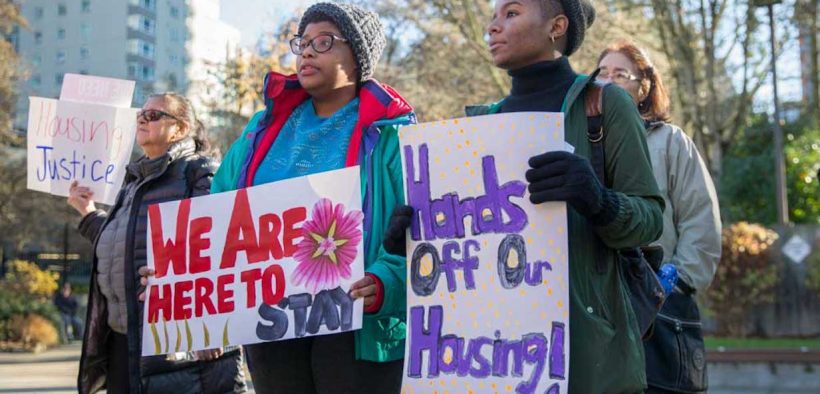The Exploding Housing Crisis In San Francisco And Around the World

“How is it acceptable that GDPs are increasing all the time … and homelessness is rising all the time?”
Residents of a waterfront San Francisco neighborhood filed a lawsuit against the city and state on Wednesday opposing the construction of a new homeless shelter near their living area. With an official count of around 8,000 homeless people in San Francisco, the conflict reflects a broader debate on how to confront the affordable housing crisis afflicting the world’s major cities.
As noted by the Guardian, the coalition of residents called for an environmental review to stall the project, which was scheduled to begin production later this summer. After the environmental appeals were rejected by the city’s board of supervisors, the oppositional resident group moved forward with a full-fledged lawsuit arguing the land’s legal status as a public trust prohibits its use as a shelter.
“We want to block the current proposed project and we intend to take it as far as we can in the courts — as far as necessary,” said Wallace Lee, a member of the group opposed to the project. “The way that the city runs navigation centers now in other parts of the city doesn’t make us feel confident that they’ll be able to run an even larger navigation center here.”
Residents Split on San Francisco’s Homeless Problem
The controversy spawned dueling GoFundMe campaigns, one supporting new shelters and one opposed to its development in the neighborhood.
Judy Lin, a resident who gave money to the GoFundMe campaign opposing the shelter, told the Huffington Post that the neighborhood residents “all want to help the homeless,” but didn’t think building a new housing complex in the “densely residential” neighborhood was an appropriate strategy.
Others argue the magnitude of the crisis demands swift action in building new shelters. CBS recently reported that the mile-long stretch of homeless people and their tents in Santa Clara county is so large it is visible from outer space.
“Locals say the problem is only getting worse and is actually driving some residents to relocate,” reported CBS San Francisco on Thursday.
Proximity to Silicon Valley, in addition to broader global trends, have ramped up housing costs in San Francisco and spiked homelessness to crisis levels. With over 8,000 homeless people in the last count and only about 2,500 shelter beds, many of the people are completely without shelter in one of the most affluent cities in the world.
“Our City is in the midst of a homelessness crisis, and we can’t keep delaying projects like this one that will help fix the problem,” said Mayor London Breed in a statement. “When we have people suffering on our streets, we need to be able to provide them with the care and services they need. This SAFE Navigation Center will help us do that and I am committed to making this site work for the people who need help and the surrounding neighborhood.”
Housing as a Financial Commodity
According to United Nations Special Rapporteur for Adequate Housing, Leilani Farha, housing has become increasingly unaffordable for hundreds of millions of people in recent years due to investors, private equity firms, and vulture firms growing ownership of the residential real estate market.
“Housing has lost its social function and is seen instead as a vehicle for wealth and asset growth. It has become a financial commodity, robbed of its connection to community, dignity and the idea of home.” Farha told the Human Rights Council in Geneva in March 2017.
Critics of corporate landlords argue their growth model, which is dependent on rising costs for tenants, is detrimental to society. In New York City, for example, landlords with more than 60 buildings evict tenants at ten times the rate of landlords who only own one property, according to Pacific Standard.
Additionally, a growing amount of property is owned by landlords with vast portfolios. In New York City, 27% of is owned by landlords with more than 61 buildings, versus only 13% owned by landlords with only one building, according to property records from December 2018.
“It’s a perpetual growth model of evicting tenants, putting new tenants in, increasing rent—rinse, recycle, repeat,” Jonathon Westin, executive director of New York Communities for Change, told Pacific Standard.
“When you think about the story of the foreclosure crisis on a broader scale, this is about the displacement of a lot of working and middle class communities of color,” Caroline Nagy, deputy director for policy and research at CNYCN, which advocates for working-class homeowners, told Pacific Standard. “[It’s] essentially a transfer of land from these communities to investors—to people who are seeking to make profit off the housing.”
In June, New York City overcame stiff opposition from the real estate lobby to pass historic rent regulations, closing several loopholes that allowed landlords to increase rent and evict tenants without adequate reason.
Meanwhile, in California, private equity firms like Blackstone, which was singled out by the U.N.’s housing advisor in March for exploiting tenants and fueling the housing crisis, have been some of the most strident opponents to rent control laws. Blackstone owns more than 12,700 single-family rentals in California and hundreds of thousands through subsidiaries worldwide, making it the world’s largest real estate management firm.
Farha, the U.N.’s housing advisor, alleges Blackstone massively inflates rents and charges unfair fees for ordinary repairs, as well as undertaking “aggressive evictions” that have “devastating consequences” for people around the world.
Blackstone’s CEO Stephen Schwartzman made $786 million in 2017 and at least $568 million in 2018.
Blackstone argues rent controls would hurt homeowners and tenants, and disputes the UN’s accusations, telling CNBC it shares “concern about the chronic undersupply of housing in major metropolitan centers around the world” and that Blackstone “has contributed to the availability of well managed rental housing by bringing significant capital and expertise to the sector.”
The Finland Model
Finland, the only E.U. country where homelessness is falling, provides an alternative model. The country invested €250m to support unconditional housing for citizens, building 3,500 new homes where people can apply for housing benefit and support services.
Since the program’s launch in 2008, the number of long-term homeless people in the country has fallen by more than 35%. A study estimates savings of €15,000 a year for every formerly homeless person provided housing in social services, emergency healthcare, and legal costs.
Additionally, many Finnish citizens formerly living in temporary housing said their newfound stability allowed them to pursue long-term employment. The U.K., which has experienced a spike in homelessness, is modeling pilot programs off the Finnish model, and other countries like France and Australia have also expressed interest in the policy.
Feantsa, a European organization dedicated to fighting homelessness, attributes Finland’s success to its view of the issue “as a housing problem and a violation of fundamental rights, both solvable, and not as an inevitable social problem resulting from personal issues.”
Leilani Farha similarly believes that homelessness needs to be viewed as the “human rights issue that it is,” arguing that “once people lose their housing and become homeless, they often are open to any of a number of social ills,” telling Al Jazeera:
“If you look at North America, if you look at Europe, what are we seeing? Rising rates of homelessness in the richest countries in the world. That, to me, is where we get into extremely shameful territory, extremely shameful. Why is that? How is it acceptable that GDPs are increasing all the time … and homelessness is rising all the time?
“People are always like, ‘Oh, the people who are homeless, they’re all crazy; they all have psychological problems’. Many, many people who hit the streets are completely of sound mind. It’s the trauma of being on the street that can trigger psycho-social disability … The trauma of living on the street is what often leads people to do things like drugs.”











